Home Classroom Setup Ideas
Organization & Decor Ideas for virtual & Distance Learning
Creating a calm, dedicated learning space for your child sets them up for successful home learning. We send our children to school to an environment dedicated to learning, and for them to concentrate and to be able to work at home, they need a similar space. It can be small. It does not need to be fancy. And if you have multiple children, they can all work together. But it is worth spending a weekend creating a dedicated space for learning for your children.
While we have a 3rd grader this year, this is the same approach I would use regardless of Bambino’s age. I used to teach high school and while middle and high school students are more independent, they still need proximity, interaction, and supervision. So, I encourage you not to send your older students away to their rooms all day, but invite their learning into the heart of the home where you can be more connected to what they are doing, and they won’t be isolated all day, too.
And a confession: remote learning was not a piece of cake at our house. Please know that. Even as a former teacher — and someone who had just redone my Workroom as part of the One Room Challenge — we were caught a bit flat-footed just like everyone else. It took a few weeks to find our stride. I have had to make huge career sacrifices (my novel is now on an indefinite hold), and we were often at our wit’s end. But, along the way we developed several low-key, low-cost strategies which helped make school at home easier for us all.
And one more thing before we begin. Remember: this is temporary but not short-term. Honestly, I suspect we will be in and out of school for at least two years. It is a normal-for-now situation. Making a dedicated school space in your home isn’t a solution for a few weeks. It is something that will help keep your family sane for the long-haul.
We set aside our breakfast room as an Art Room. Now it is our home classroom.
Set up a Dedicated Work Space or Classroom
If your home is large enough, and I know that’s not true for every home, set this place aside only for school. Create a spot that can be JUST the classroom. It’s often said right now that we aren’t working from home; we are living at work. And as school begins, we are also living at school. Being able to leave school supplies out and books in their spot if possible makes school feel more real, and it also makes it easier to function.
With multiple children, I think this is even more important. Older children can help younger children at times, and being together — even with earphones on — makes school a little more enjoyable. Obviously, this also means respectful rules are important. Everyone needs to be able to function independently. But even teens benefit from a structured, collaborative environment.
Our answer: convert the Art Room into our Classroom. Our Art Room is what most people would use as the breakfast room or eat-in kitchen. With a dining room just steps away, we dedicated this space to creativity from the day we moved in. We furnished the Art Room simply: a table and chairs along with two vintage dressers purchased from the Facebook Marketplace. The dressers hold art supplies and all manner of materials for making and creating. I have more about organizing a home art studio as well as ideas for establishing creative spaces in your home in other posts. Click the links.
We have made some changes to the Art Room to make it more conducive to school work including implementing all of the tips I recommend here. It is central in our open floor plan home, so my husband and I can share supervision and tech support responsibilities as needed. And we have all of the necessities for school now at hand in one place.
Our Art Room would work for multiple children, and it is decorated simply. There is no need to overload on school decorations — they can be very distracting for students.
School supplies are right at hand in our home classroom.
My Workroom also could be easily converted to workspace for 3-4 people. I have a full tutorial for creating a wall-mounted desk from countertops and other ideas for outfitting a comfortable workspace in my posts about the 2019 ORC Workroom Makeover.
Location! Location! Location!
Where should your kids work? NOT in their bedrooms if you can help it. Even with teens, a closed bedroom door makes supervising your kids harder. And experts advise people not to work in their bedrooms — the same applies to children. Bedrooms should be places of rest, relaxation, and play. Keep school separate.
Every home is different, but here are a few suggested locations:
Guest bedroom: you won’t be having guests for the near future, so why not convert your unused room into a classroom (unless, of course, it is already the office space for you or your partner)
Dining room or eat-in kitchen: do you have more than one eating space in your home? Convert the least-used space into your classroom.
Playroom or basement: if you have a playroom, convert a corner or more into the classroom.
A bedroom: perhaps during this time, your children can share a room (they may love it). Convert one of their rooms into a dedicated classroom.
The garage: if you live in a temperate climate, this could also be a good solution! Move the cars to the driveway and set up in the garage. On nice days, you can even leave the doors open all day!
A shed: could you covert an old garden shed or playhouse into a classroom space?
A patio or porch: if you live in a temperate part of the world, perhaps a patio or porch would make a good school space. Learning outside has so many benefits for kids of all ages.
The Backyard: create an outdoor classroom if your weather allows. This doesn’t work in Minnesota all year, but here in Colorado — and in many parts of the country, this might be a great solution!
A closet: there are so many great examples of closets-turned-offices which might be a fabulous work space for a child or teen (or yourself). Think about a hall closet or other space that might be a good conversion.
The awkward space: is there a strange cupboard under your stairs? Or an odd entryway? What about that weird back hallway no one really uses? Consider every square foot of your home as potential. You might be surprised!
Think about the spaces you use everyday — and then identify the unused or underused places in your home.
Table or Desk & Comfortable Chairs
Whether your school will be online for hours at a time or your child will be checking in a few times per day, they will need a comfortable place to sit and to work. Make sure the table is at an appropriate height. Again, it doesn’t have to be fancy. We have used countertops to make desks and tables with hairpin legs which can be ordered in almost any height. You can make a table from an old door, and the Facebook Marketplace is full of tables and desks — sometimes even for free — which would make good work surfaces. If the table legs are too tall, cut them down to the right height. Searching for “school table” or “adjustable table” may produce results from schools, churches, or childcare facilities getting rid of normally-expensive equipment, too. Adjustable-height tables are great for classrooms!
In our Art Room the table is an IKEA table top cut to length and assembled with legs from DIYHairpinLegs.com. We added some old IKEA legs to the off-cut to create a shelf for the back end of the table which makes for more storage.
In my Workroom, the desk is made from several IKEA countertops mounted to the wall and again supported by legs from DIYHairpinLegs. There’s a full tutorial for the desk here.
The chairs in the Art Room are vintage classroom chairs from the 1950s that I bought years ago. They are fabulous! In my Workroom I have Herman Miller Aeron Chairs which I bought used and LOVE!
Whatever you do, be sure the space is comfortable for adults, too. The reality is your kids may need you there for more than just a brief question at times. It may not be your primary work space, but make a place where you can be comfortable, too. Have chairs that are appropriately-sized for your kids as well as for you. Make sure there is an empty spot at the table in case you need to answer emails while they work.
My workroom features a desk which is 11’ long! A desk like this would be great for multiple kids working in one room.
Our Classroom ready for the beginning of the school year!
With multiple children, you may need chairs at varying heights. Bambino likes to put an inflatable balance disc on his chair to make the height better for his body — and it makes the chair more comfortable. Yoga balls can make great chairs for children — especially kids who need more movement in their day. They make it easier to focus for some kids; just make sure they are at the appropriate height for good posture. I like the yoga balls with stands — they are a little less precarious.
Simple, Clean, & Clear
Your classroom space does not need to be cutesy, colorful, or filled with “school stuff.” In fact, studies show that simple, clear schoolrooms are better for children’s learning. There is no need to go overboard with decorations, charts, or accessories. These items can be a distraction. Take a note from the Montessori and Reggio Emilia school approaches: a clean and uncluttered school environment with purposeful decor drawn from the natural world.
Many Reggio Emilia classrooms, for example, have a simple branch hung from the ceiling. Children’s work is hung from the branch and is curated often. Having space to display noteworthy work makes a child feel appreciated and valued, so if possible, incorporate a place to display a sampling of work done by your child. We have a branch hanging over our dining room table which is inspired by this idea, and we love it!
In our Classroom we have a set of clipboards installed on the wall. Bambino curates that wall, putting up pieces he is particularly proud of and switching them out as desired. Not only does he get to show off his school work, but he also takes ownership of what is displayed and when it is time to rotate out old work for new. And a paper cutter makes for easy access to large paper which is fabulous for painting and drawing as well as doing math projects, doodling, and an infinite number of other uses.
Clipboards make curating artwork displays easy! We also set aside space on the tops of each dresser for three-dimensional art displays.
Buy the School Supplies
It may be tempting not to buy school supplies if your child will be at home from the start of the school year. But I encourage you to buy them anyway. Your child needs the right tools to be able to do their work at home, and school supplies are a big part of that. Working from home is disruptive, but having the right supplies around helps to normalize the distance learning experience. If your school did not send home a list of necessary supplies, here are some suggestions:
Pencils
Pens: for middle and high school students; erasable pens are helpful
Markers
Crayons
White printer paper
Colored paper/construction paper
Ruled paper: wide rule for elementary school and college rule for middle and high school
Graph paper
Glue sticks
White school glue
Scissors
a binder
dividers
a three-hole punch
For a complete list of school supplies by ages and grades, check out:
School Supplies List
for School at Home
School supplies are ready for the beginning of the year!
Storage Ideas for School Supplies
I am big on bins and jars for keeping supplies handy, personally. Most of our pens and pencils and markers are kept in glass pickle jars or jelly jars — things that might otherwise be recycled. But it keeps everything tidy and organized — and right at hand. And it isn’t expensive, either. Look at your recycling for jars, tin cans, and cardboard boxes. You can certainly dress them up with stickers, wrapping paper, or original artwork. The storage doesn’t need to be fancy to be helpful!
If you have room, designate a dresser or a cupboard for school supplies and materials. Creating a space for items to be organized will bring order to your classroom and will help kids know how to keep it tidy — reducing stress for everyone involved. The Facebook Marketplace is a fabulous place to find cast-off furniture which can become good storage for your schoolroom. It doesn’t have to be fancy — just functional!
I love glass jars! Rescued from the recycling bin, they make wonderful storage for all kinds of school and art supplies.
We keep pens, skinny markers, pencils, scissors, and paint brushes in glass jam jars — all saved from the recycling. These containers fit perfectly in a kitchen turntable for easy access. I like the kind with sides and handles — it keeps everything contained and is easy to move around as needed. I have the same thing on my own desk, too!
I also have simple storage bins for large markers, crayons, and colored pencils.
A kitchen turntable holds lots of pens, pencils, and markers, ready for school to begin.
I have a turntable full of supplies on my desk, too.
Make sure you have a spot for paper — a paper sorter is great for that. And text books, notebooks, and folders will all need a place, too. We cut the table in our Classroom down to better fit in the room The off cut — about 18 inches — makes a perfect shelf mounted on some IKEA legs we had left over from another project. Using items we already had around the house, and a few jars from the recycling, made this a very cheap project! And if your kids know where everything is, they will be more self-sufficient during the day.
Graph paper and lined paper are separated and wait in paper sorting trays for school to start.
A jar of flowers makes a pretty bookend for notebooks and folders.
a White Board or An Easel
We have had our easel for years. It was someone else’s castoff by the side of the road one day when we lived in San Francisco. I cleaned it up, bought some markers and chalk, and it has been the centerpiece of our art room ever since.
In a schoolroom, a white board is really important, too. You can use them for any number of things — teaching concepts, kids can work on them which can then be photographed and shared with teachers. You can keep the daily schedule or track assignments on a white board if it is big enough. And while a child is participating in class, it might be easier for the child to do some work on a white board where the teacher can see more easily. Again, the Facebook Marketplace is a great place to find old whiteboards. You can also buy whiteboard paint if you have smooth walls — or even paint an old door or a piece of plywood for a cheap option.
Our easel was free by the side of the road! But there are lots of places to find one second-hand to save money.
Lamps and Good Lighting
Every work space needs good lighting. If the area you have designated as a classroom doesn’t have good lighting, add some task lamps so your child isn’t straining to work. The space should be flooded with light — not just from above which can create harsh shadows on work areas. Task lamps make writing and reading easier. If you have multiple people working at a table, think like an old school library — give each work space task lighting to make work easier.
Our Art Room has lovely natural light from a glass door as well as skylights. However, when winter comes, I will probably need to add some task lighting and perhaps upgrade our overhead fixture. Good lighting is layered — natural, overhead, task, and accent lighting. We haven’t addressed lighting in this room yet, but I suspect that will be on the agenda soon!
With winter coming, we will need to replace the light fixture in our Classroom and add a lamp or two to make this space more functional as the days grow shorter.
Other Helpful Tools
Power strips
There’s nothing more frustrating than juggling outlets and multiple devices. Use a powerstrip so everyone has a place to plug in as needed, and manage your cords if there are lots of devices for multiple users.
A Printer
Most children don’t learn to type efficiently until middle school or later. If your child doesn’t type well, print off assignments, so they can be completed by hand. Then scan them and turn them in. This can save a LOT of frustration both for parents and for students. Technology can be a difficult barrier for many students who are accustomed to handwriting their work each day. Additionally, learning is actually deeper and longer-lasting when assignments are hand-written, so it is better for your child to complete their assignments by hand. Start each day or each week by printing everything out so it is accessible and easy to complete.
I ended up buying a new printer about a month into remote learning because my old printer broke — it was the best money I’ve spent in a long time, too. Newer printers can even be used with smart phones, so if you don’t have a computer in your home, a printer is still a good investment and can make turning in work easier and less frustrating. Our printer is in my office, because my child isn’t knowledgable enough to do his own printing, yet. But if your kids are older, make a space for the printer and some printer paper in your classroom. And invest in black ink!
Headphones with a Mic
With multiple people in the house trying to work at the same time, headphones are a necessity. There are times when all three of us are on zoom calls simultaneously, and that’s when we pull out the headphones.
I am cautious about using headphones. When Bambino is wearing them, I’m not able to supervise him as closely, and headphones can damage a child’s hearing. However, they are a tool to be deployed when necessary, and with multiple children they become even more important. Make sure the headphones are appropriately-sized for children and have a mic so your student can participate fully in class activities.
As you embark on this school-from-home adventure, I wish you all the best! I hope dedicating a space in your home to schooling makes it all a little easier for you and your family!


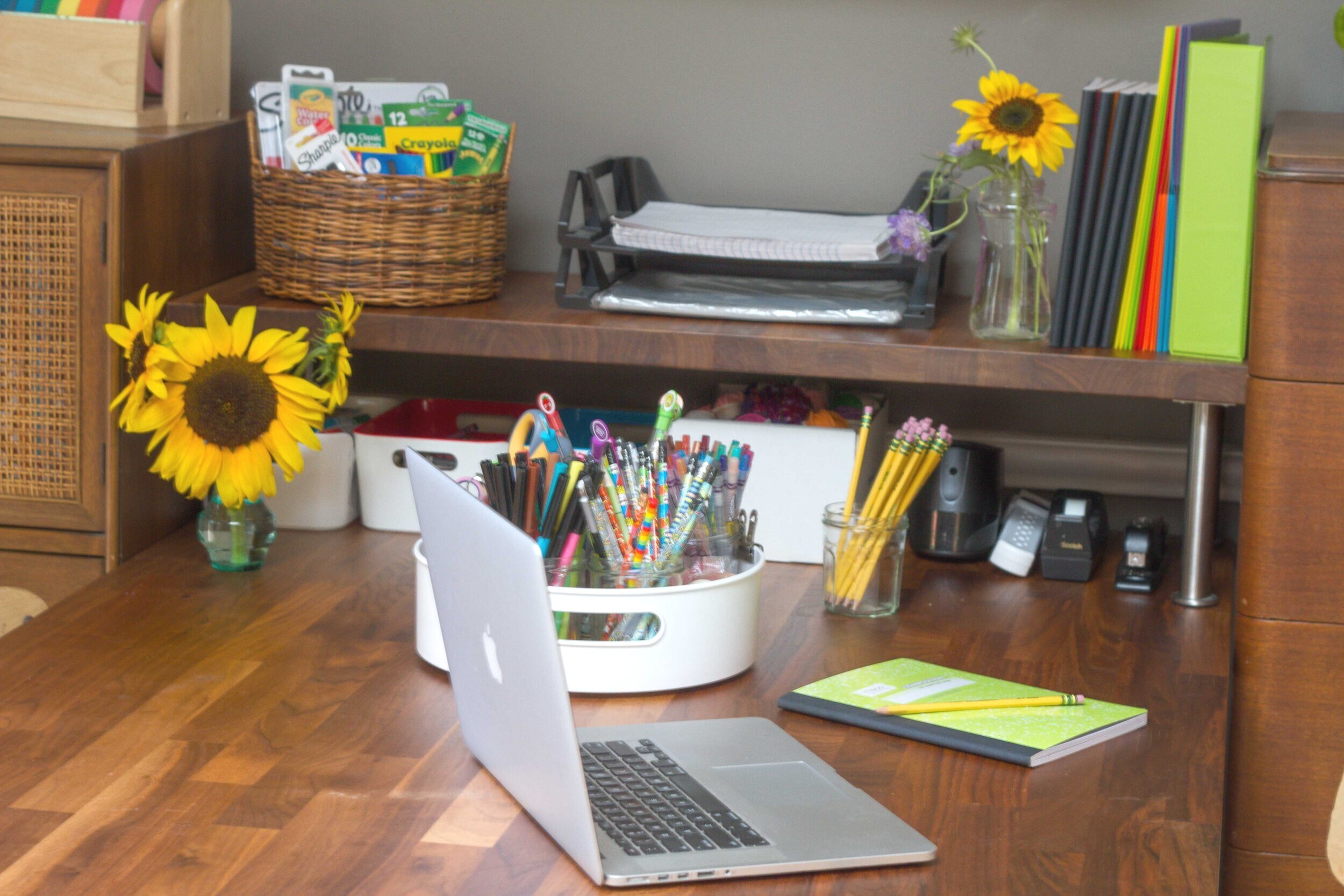
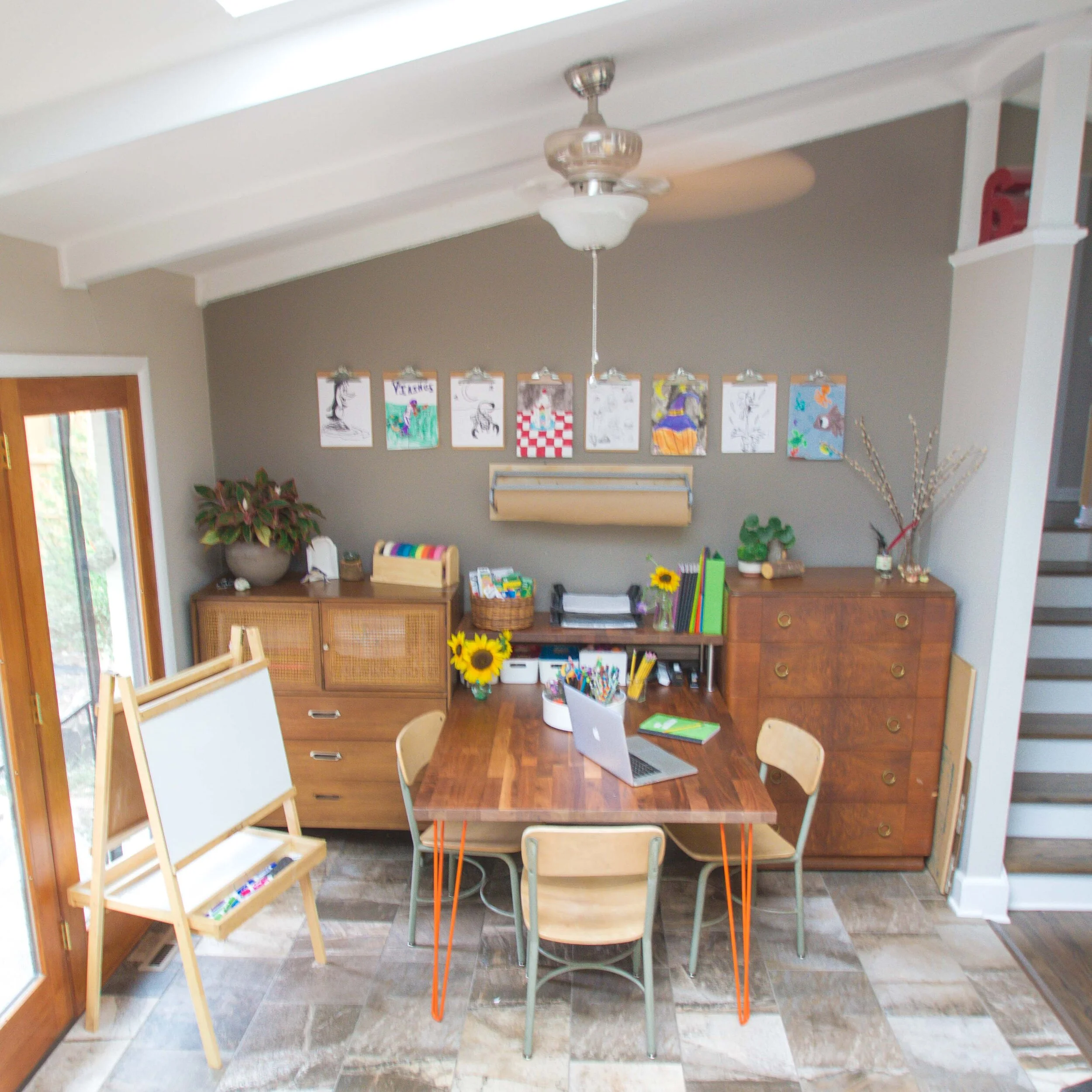
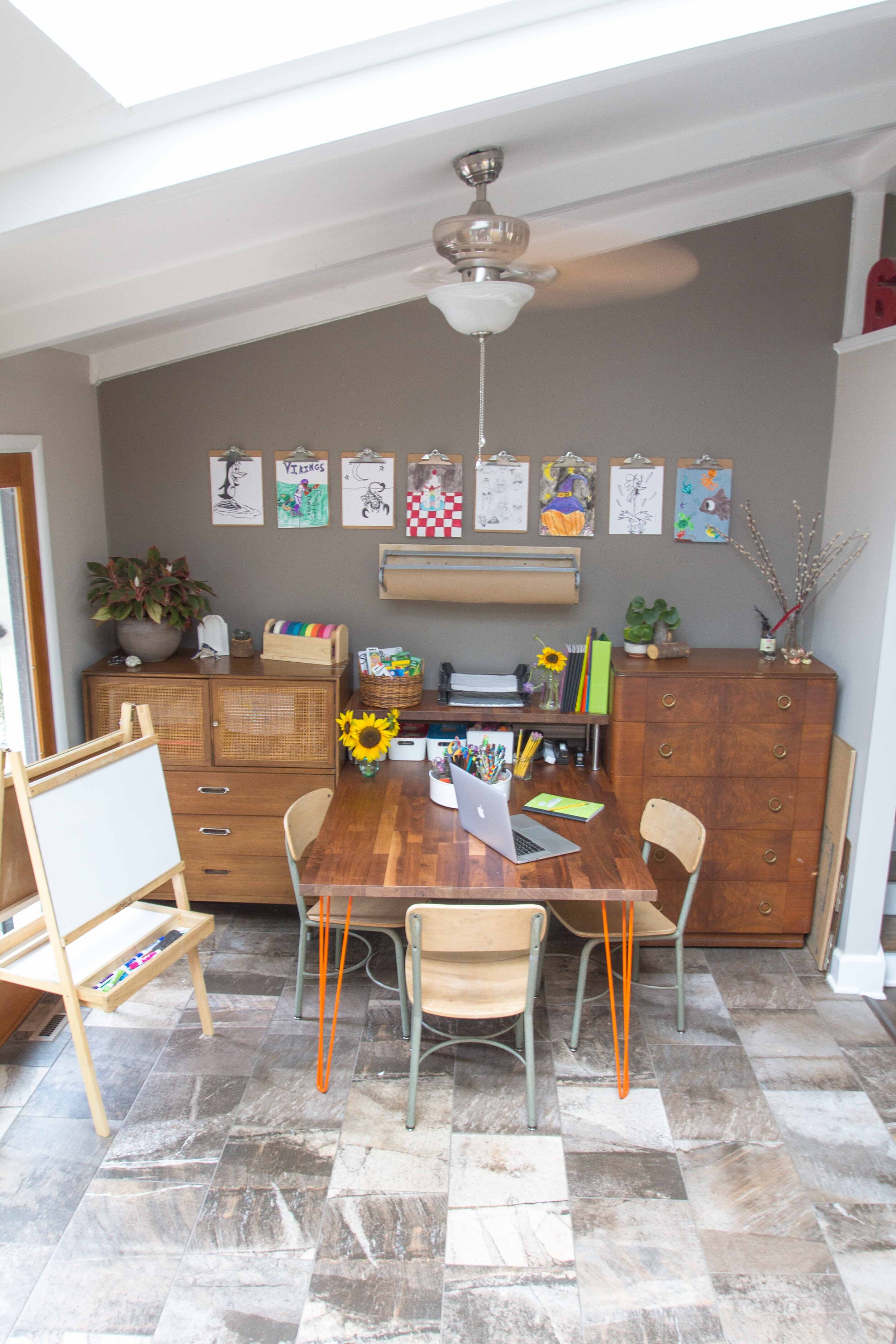

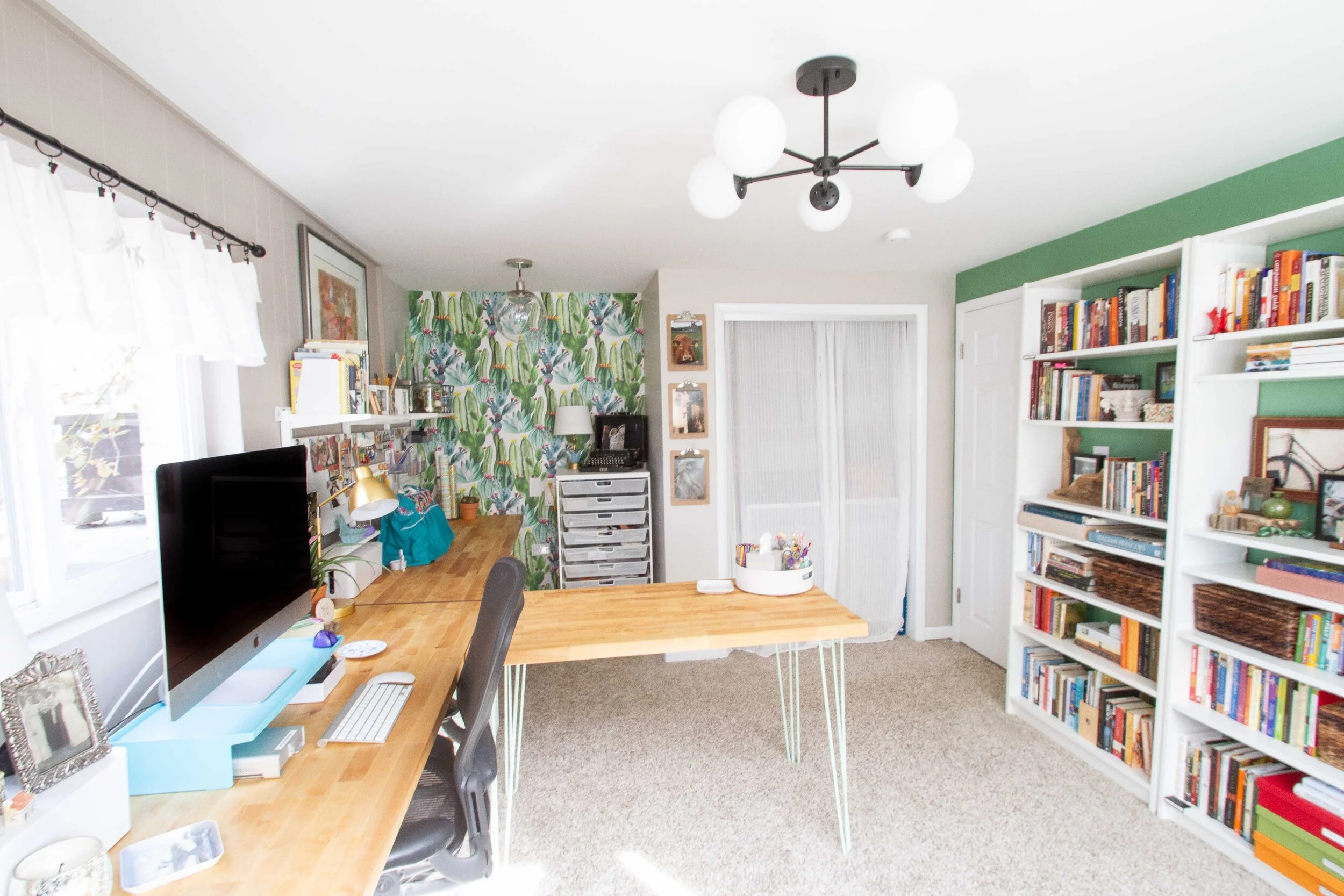








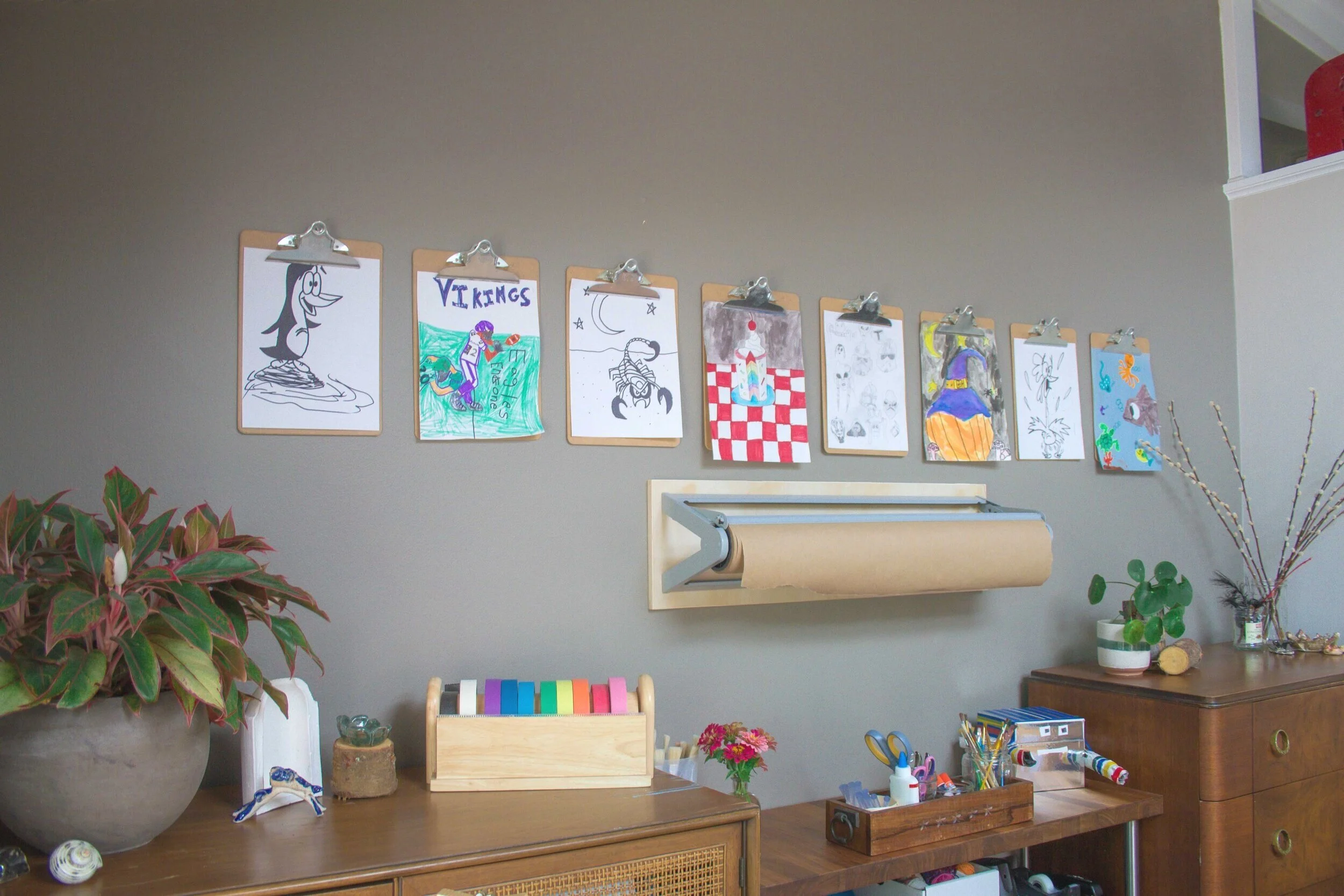






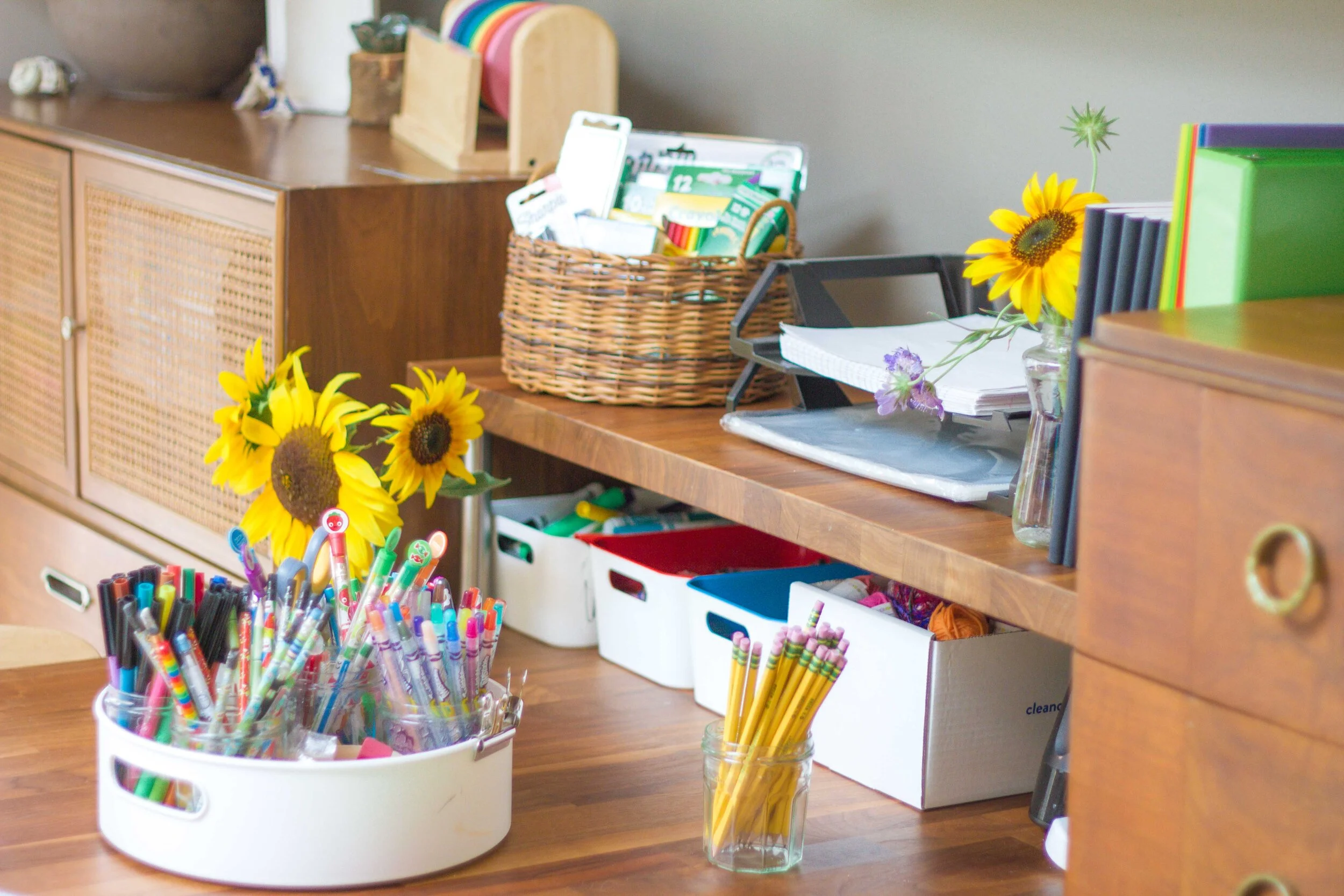













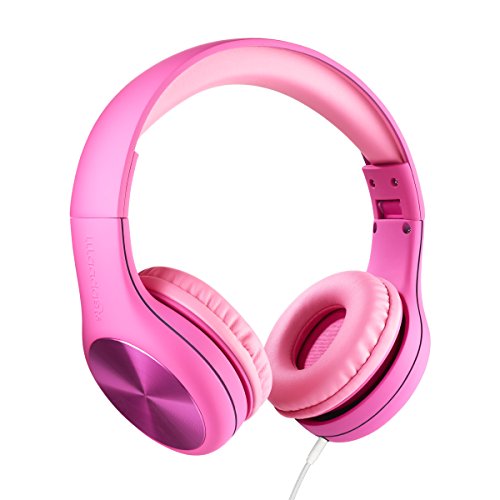





Tips for at-home learning, a tutorial for comfortable face masks, and more!